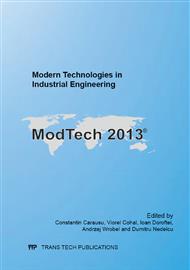p.458
p.464
p.471
p.477
p.483
p.489
p.495
p.500
p.506
Longitudinal Loop Power Flow Analysis on a 4x4 Transmission Vehicle Taking into Consideration the Running Track Type
Abstract:
This paper presents an analysis for the longitudinal loop power flow of a 4x4 driven vehicle type taking into consideration the influence of the running track. The goal set up by this paper is to experimentally verify the existence of a certain dependency between the longitudinal loop power flow and the type of the running track the vehicle is moving on. Such a determination could have a positive impact by optimizing the vehicle exploitation or even its modernization. The loop power-flow is the result of the self-generated torque within the automobiles transmission, which is, at its turn, a consequence of cinematic misfits during the rolling process of the wheels. The mathematical model stated in this paper is confirmed by the means of multiple tests developed in real conditions. In order to carry out experimental research we used an all-driven, wheeled military APC, reconnaissance vehicle. The longitudinal power flow was determined with the vehicle moving in straight motion but having different rolling radius between the axles. The rolling radii of the wheels of the same axle were the same. The difference between the rolling radii was set to 0.03 m then to 0.05 m. The vehicle traveled on tarmac then on grass. The transmission of a vehicle that is susceptible in generating loop power-flow can be updated to decrease and technically eliminate it. Prior to such an update, a thorough analysis of the transmission working regimes should be performed, especially of those regimes that are most probable to generate loop power-flow. The paper presents the equipment used to perform the measurements and the way it was mounted on the vehicle. It also presents the values for the longitudinal power flow, recorded for both rolling radii differences. The results are presented in graphic display. Eventually, the paper presents the longitudinal power flow taking into account the difference between the rolling radii and its dependency towards the running tracks type. This study can be extended to all the 4WD automobiles, which have special traction control devices. The results obtained were processed in order to underline the power loops within the longitudinal transmission. Thus, important and interesting results could be drawn.
Info:
Periodical:
Pages:
483-488
Citation:
Online since:
November 2013
Authors:
Keywords:
Price:
Сopyright:
© 2014 Trans Tech Publications Ltd. All Rights Reserved
Share:
Citation:


